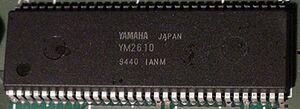YM2610: Difference between revisions
mNo edit summary |
No edit summary |
||
| Line 8: | Line 8: | ||
== Communication == | == Communication == | ||
The YM2610 is programmed through | The YM2610 is programmed through two pair of "ports": A and B. They're usually called Address A, Data A, Address B, Data B. | ||
They're respectively linked to the Z80's ports 4 to | They're respectively linked to the Z80's ports 4, 5, 6 and 7. | ||
* Port A (Z80 ports 4 and 5) concerns the SSG, ADPCM-B and FM channels 1 and 2. | |||
* Port B (Z80 ports 6 and 7) concerns the ADPCM-A and FM channels 3 and 4. | |||
* Data A (Z80 port 5) can also be read ? | |||
The Z80's A0 and A1 lines are directly connected to the YM2610's A0 and A1 inputs. A2 informs the [[NEO-D0]] chip that the I/O request is for the YM2610. | |||
== Sound generation parts == | == Sound generation parts == | ||
| Line 30: | Line 36: | ||
The ADPCM-A part has 6 channels, with a fixed playback frequency of 18.5kHz. Samples can be any size from 256 bytes to 1MB, by 256 bytes increments. | The ADPCM-A part has 6 channels, with a fixed playback frequency of 18.5kHz. Samples can be any size from 256 bytes to 1MB, by 256 bytes increments. | ||
The ADPCM-B part only has 1 channel, but the frequency can be changed. | {| class="regdef" | ||
|'''YM 2610 port name''' | |||
|'''Address (Z80 port 6)''' | |||
|'''Data (Z80 port 7)''' | |||
|- | |||
|rowspan="7"|Port B (Z80 ports 6 and 7) | |||
|$00 | |||
|{{8BitRegister|Dump|1|-|1|CH6 ON|1|CH5 ON|1|CH4 ON|1|CH3 ON|1|CH2 ON |1|CH1 ON|1}} | |||
|- | |||
|$01 | |||
|{{8BitRegister|-|2|Master volume|6}} | |||
|- | |||
|$08~$0D (one for each channel from 1 to 6) | |||
|{{8BitRegister|L|1|R|1|-|1|Channel volume|5}} | |||
|- | |||
|$10~$15 (one for each channel from 1 to 6) | |||
|{{8BitRegister|Sample's start address/256 LSB|8}} | |||
|- | |||
|$18~$1D (one for each channel from 1 to 6) | |||
|{{8BitRegister|Sample's start address/256 MSB|8}} | |||
|- | |||
|$20~$25 (one for each channel from 1 to 6) | |||
|{{8BitRegister|Sample's stop address/256 LSB|8}} | |||
|- | |||
|$28~$2D (one for each channel from 1 to 6) | |||
|{{8BitRegister|Sample's stop address/256 MSB|8}} | |||
|} | |||
The ADPCM-B part only has 1 channel, but the playback frequency can be changed. | |||
[[Category:Chips]] | [[Category:Chips]] | ||
[[Category:Audio system]] | [[Category:Audio system]] | ||
Revision as of 17:11, 21 February 2011

The YM2610 is a sound synthesis chip made by Yamaha, used in every of the NeoGeo's hardware versions. It was merged with the Z80, the YM3016 and the Z80 memory controler in the NEO-YSA chip on late revisions of the NeoGeo CD and CDZ.
Its analog outputs only sound generated by the SSG. The FM and ADPCM parts use an external YM3016 DAC.
Communication
The YM2610 is programmed through two pair of "ports": A and B. They're usually called Address A, Data A, Address B, Data B. They're respectively linked to the Z80's ports 4, 5, 6 and 7.
- Port A (Z80 ports 4 and 5) concerns the SSG, ADPCM-B and FM channels 1 and 2.
- Port B (Z80 ports 6 and 7) concerns the ADPCM-A and FM channels 3 and 4.
- Data A (Z80 port 5) can also be read ?
The Z80's A0 and A1 lines are directly connected to the YM2610's A0 and A1 inputs. A2 informs the NEO-D0 chip that the I/O request is for the YM2610.
Sound generation parts
Its able to produce sound using SSG, FM synthesis and ADPCM playback.
SSG (Simple Sound Generator)
Given its limited capacities, the SSG is rarely used for music in NeoGeo games. It's more often used for sound effects like coin-in, continue countdowns or "GO >>>" indicators in side-scrollers.
The SSG part has 3 square wave channels with programmable frequency, and a LFSR noise channel, all with programmable amplitude. An unique enveloppe generator with predefined shapes can also be linked to the SSG's channels amplitudes. (Is SSG only mono ?)
FM (Frequency Modulation)
The FM part has 4 channels, each having their own parametrable operators, panning and amplitude. It's the most used way of generatic music in games.
ADPCM
APDCM playback allows sampled sounds to be played along with the synthesized ones. Its used for anything that can't be easily synthesized like voices, percussions or wind instruments. Viewpoint uses a lot of sampled drum loops and explosion sounds.
The ADPCM-A part has 6 channels, with a fixed playback frequency of 18.5kHz. Samples can be any size from 256 bytes to 1MB, by 256 bytes increments.
| YM 2610 port name | Address (Z80 port 6) | Data (Z80 port 7) | ||||||||||||||||||
| Port B (Z80 ports 6 and 7) | $00 |
| ||||||||||||||||||
| $01 |
| |||||||||||||||||||
| $08~$0D (one for each channel from 1 to 6) |
| |||||||||||||||||||
| $10~$15 (one for each channel from 1 to 6) |
| |||||||||||||||||||
| $18~$1D (one for each channel from 1 to 6) |
| |||||||||||||||||||
| $20~$25 (one for each channel from 1 to 6) |
| |||||||||||||||||||
| $28~$2D (one for each channel from 1 to 6) |
| |||||||||||||||||||
The ADPCM-B part only has 1 channel, but the playback frequency can be changed.